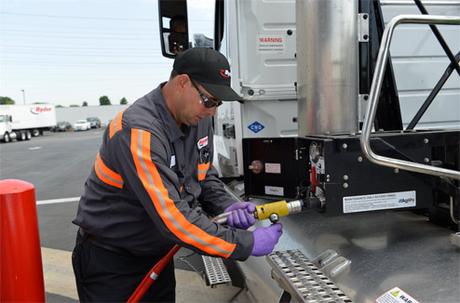 It’s a persistent challenge for food and beverage transportation managers: How to squeeze the last drop of fuel efficiency from each mile traveled, while also avoiding fuel price volatility and complying with changing government regulations. Through its partnership with Ryder, Eagle Distributing found the answer in a well-planned transition to natural gas vehicles.
It’s a persistent challenge for food and beverage transportation managers: How to squeeze the last drop of fuel efficiency from each mile traveled, while also avoiding fuel price volatility and complying with changing government regulations. Through its partnership with Ryder, Eagle Distributing found the answer in a well-planned transition to natural gas vehicles.
During a recent Food Logistics webinar entitled, “Natural Gas Fleets: the secret ingredient for stable fuel costs and compliant emissions,” Eagle and Ryder executives discussed the steps taken and lessons learned from their fleet conversion from diesel to natural gas.
Natural gas has become a “best of all worlds” business strategy for organizations seeking fuel price stability, increased efficiency, and sustainable stewardship – especially amid increasing governmental regulations. But how can a company long tied to diesel best transition to natural gas?
For Eagle Distributing, which delivers alcoholic and non-alcoholic beverages to 1,100 accounts weekly along 6,500 miles of local and over-the-road routes throughout Louisiana, the move to a sustainable resource was no surprise. The company began recycling decades ago and continues to see itself as a leader in sustainability.
“We are constantly looking for green initiatives for conserving energy, reusing items, or recycling,” says Robert A. “Bobby” Nichols, Chairman of Eagle Distributing of Shreveport. “So compressed natural gas (CNG) was an obvious advantage for us to leverage as a green initiative.”
What did Eagle learn from its move to CNG vehicles?
- Start small. Eagle began by bringing on four CNG-powered sales vehicles to better understand what the transition would entail. Once employees embraced the move, the company took delivery of more vehicles. Over the next several months, Eagle transitioned out older diesel vehicles and took delivery of 24 natural gas vehicles. Eagle still uses several diesel units for remote markets where natural gas fueling stations are not yet available.
- Be part of a bigger effort. It helped that the cities of Shreveport and Bossier, which were involved in natural gas conversions of their own, built four natural gas stations for community use. Eagle eventually partnered with another local company to build their own fueling stations.
- Educate those who’ll be affected. Eagle’s drivers were skeptical at first. They feared loss of power or limited refueling capacity. So Eagle educated its drivers to boost acceptance. Drivers eventually appreciated being at the wheel of state-of-the-art technology that was quieter and cleaner, and whose fuel was domestically sourced. In fact, a large natural gas reserve exists in North Louisiana’s Haynesville shale region. Drivers soon saw themselves as environmental stewards using a locally-sourced product.
- Look for incentives. Louisiana offers various grants and incentives for converting fleets to natural gas. So do California, Colorado, Texas, Georgia, Florida, North Carolina, Illinois, Ohio, Pennsylvania, Maryland, Delaware, and New York. These can help offset the costs of acquiring and operating such vehicles. Eagle also tapped Ryder’s Flex-to-Green program, which allows the company to swap out diesel for natural gas units without penalty when the situation or timing is right.
- Calculate the costs. Eagle executives realized upfront costs are offset by environmental benefits in the near term, and any eventual rise in diesel costs in the long term. Moreover, as natural gas fuel tank technology increases the diesel gallon equivalent (DGE) – one configuration can deliver 1,100 miles on a single fill up – more OEMs and truck manufacturers will collaborate to deliver units with even greater range.
- Study the factors that make natural gas work. Whether converting all or part of a fleet, make an informed decision. Spec the right vehicle type and application, including expected hours of service, cost of fuel, duty cycle (whether local or over the road), and frequency or availability of refueling stations on the projected route.
Eagle today enjoys decreased exposure to fuel price volatility, a reduced carbon footprint, and a positive halo in the community, especially as its efforts have been profiled by local newspapers and TV stations. Eagle credits a well-planned transition and its various allies who helped ease the move.
“Our partnerships were the most important part of converting to CNG,” Trey Rives, Eagle’s Operations Manager, told attendees. Added Nichols, “More people in our area are aware of CNG advantages and appreciate Eagle moving that way.”
To listen to the recorded webinar, hosted by Food Logistics magazine and sponsored by Ryder, in its entirety, click here.

